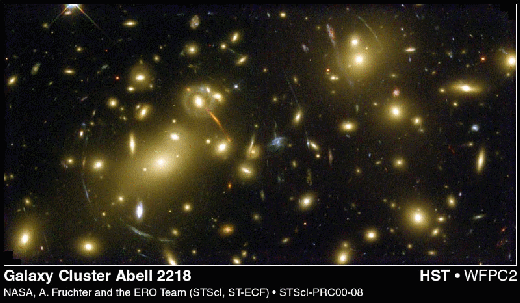A&A press release: Einstein Year 2005... (31 May 2005)
- Details
- Published on 31 May 2005
A&A press release
Released on May 31st, 2005
|
Einstein Year 2005: Measuring the shape of distant stars using gravitational microlensing |
Based on the article “Determination of stellar shape in microlensing event MOA 2002-BLG-33", by Rattenbury et al.
(Published in Astronomy & Astrophysics. )
For the first time, an international team of astronomers [1], led by N.J. Rattenbury (from Jodrell Bank Observatory, UK), applied gravitational lensing techniques to determine the shape of a star. These techniques rely on the gravitational bending of light rays. If light coming from a bright source passes close to a foreground massive object, the light rays will be bent, and the image of the bright source will be altered. If the foreground massive object (the “lens”) is point-like and perfectly aligned with the Earth and the bright source, the altered image as seen from the Earth will be a ring shape, the so-called “Einstein ring”. However, most real cases differ from this ideal situation, and the observed image is altered in a more complicated way. The image below shows an example of gravitational lensing by a massive galaxy cluster.

distorts images of faraway galaxies that appear as “arcs” throughout the picture.
Copyright NASA/HST.
The microlensing technique has been applied to search for dark matter around our Milky Way and other galaxies. This technique has also been used to detect planets orbiting around other stars. For the first time, Rattenbury and his colleagues were able to determine the shape of a star using this technique. The microlensing event that was used was detected in July 2002 by the MOA group. The event is named MOA 2002-BLG-33 (hereafter MOA-33). Combining the observations of this event by five ground-based telescopes together with HST images, Rattenbury and his colleagues performed a new analysis of this event.
The lens of event MOA-33 was a binary star, and such binary lens systems produce microlensing lightcurves that can provide much information about both the source and lens systems. The particular geometry of the observer, lens and source systems during the MOA-33 microlensing event meant that the observed time-dependent magnification of the source star was very sensitive to the actual shape of the source itself. The shape of the source star in microlensing events is usually assumed to be spherical. Introducing parameters describing the shape of the source star into the analysis allowed the shape of the source star to be determined.
Rattenbury and his colleagues estimated the MOA-33 background star to be slightly elongated, with a ratio between the polar and equatorial radius of 1.02 -0.02/+0.04. However, given the uncertainties of the measurement, a circular shape of the star cannot be completely excluded. The figure below compares the shape of the MOA-33 background star with those recently measured for Altair and Achernar. While both Altair and Achernar are only a few parsecs from the Earth, the MOA-33 background star is a more distant star (about 5000 parsecs from the Earth). Indeed, interferometric techniques can only be applied to bright (thus nearby) stars. On the contrary, the microlensing technique makes it possible to determine the shape of much more distant stars. Indeed, there is currently no alternative technique to measure the shape of distant stars.
This technique, however, requires very specific (and rare) geometrical configurations. From statistical considerations, the team estimated that about 0.1% of all detected microlensing events will have the required configurations. About 1000 microlensing events are observed every year. They should become even more numerous in the near future. The MOA group is presently commissioning a new Japan-supplied 1.8m wide-field telescope that will detect events at an increased rate. Also, a US led group is considering plans for a space-based mission called Microlensing Planet Finder. This is being designed to provide a census of all types of planets within the Galaxy. As a by-product, it would also detect events like MOA-33 and provide information on the shapes of stars.

Fig. 2 - Comparison of the MOA-33 source oblateness with recent optical interferometry results for Achernar and Altair.
Determination of stellar shape in microlensing event MOA 2002-BLG-33
by N.J. Rattenbury, F. Abe, D.P. Bennett, et al.
Published in Astronomy & Astrophysics (DOI number: 10.1051/0004-6361:20052858)
Contact persons:
- Science:
Dr. Nicholas J. Rattenbury
Jodrell Bank Observatory
SK11 9DL Macclesfield
Cheshire, UK
Phone: +44 (0)1477 572653 - Email: This email address is being protected from spambots. You need JavaScript enabled to view it.
- Press office:
Dr. Jennifer Martin
Journal Astronomy & Astrophysics
61, avenue de l'Observatoire
75014 Paris, France
Phone: +33 1 43 29 05 41 - Email: This email address is being protected from spambots. You need JavaScript enabled to view it.
© Astronomy & Astrophysics 2005


